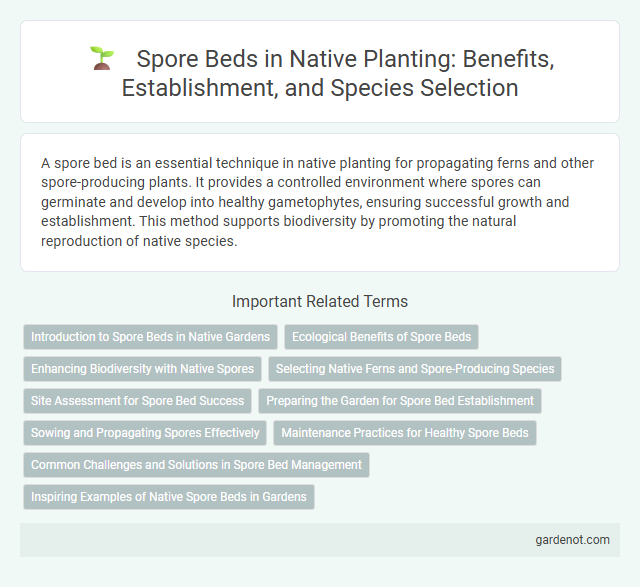A spore bed is an essential technique in native planting for propagating ferns and other spore-producing plants. It provides a controlled environment where spores can germinate and develop into healthy gametophytes, ensuring successful growth and establishment. This method supports biodiversity by promoting the natural reproduction of native species.
Introduction to Spore Beds in Native Gardens
Spore beds provide an ideal environment for cultivating native ferns by mimicking natural damp, shaded habitats essential for spore germination and growth. These beds typically consist of a moist, well-draining substrate rich in organic matter that supports the delicate life cycle of native fern spores. Incorporating spore beds into native gardens enhances biodiversity and helps preserve indigenous fern species through natural propagation.
Ecological Benefits of Spore Beds
Spore beds enhance soil biodiversity by providing a microhabitat for fungi, bacteria, and other microorganisms essential for nutrient cycling. These fungal networks improve plant health and resilience by facilitating efficient nutrient and water uptake. Establishing spore beds supports ecosystem stability and promotes native plant growth in restoration projects.
Enhancing Biodiversity with Native Spores
Spore beds foster biodiversity by encouraging the natural propagation of native fungi, which play essential roles in ecosystem health and nutrient cycling. Introducing native spores into spore beds supports symbiotic relationships between fungi and plants, improving soil structure and plant resilience. These biodiverse fungal communities enhance habitat complexity, benefiting native flora and fauna and promoting ecosystem stability.
Selecting Native Ferns and Spore-Producing Species
Selecting native ferns and spore-producing species for a spore bed enhances local biodiversity and supports ecosystem resilience. Ideal candidates include species like Dryopteris marginalis (marginal wood fern) and Asplenium platyneuron (ebony spleenwort), which propagate efficiently via spores in shaded, moist environments. Creating optimal conditions with native soil and consistent moisture promotes successful germination and growth, ensuring healthy fern populations.
Site Assessment for Spore Bed Success
Site assessment for spore bed success involves evaluating soil pH, moisture levels, and light exposure to create optimal conditions for native fern spores to germinate. Identifying native species composition and monitoring microhabitat stability ensures the spore bed mimics natural environments, promoting healthy growth. Regular soil testing and adjusting organic matter content support nutrient availability, enhancing spore viability and establishment.
Preparing the Garden for Spore Bed Establishment
Preparing the garden for spore bed establishment requires selecting a shaded, moist area with well-drained soil to encourage optimal fungal growth. Removing existing vegetation and gently loosening the soil enhances spore-to-soil contact and promotes spore germination. Maintaining consistent moisture levels without waterlogging supports the delicate mycelium development critical for a successful native spore bed.
Sowing and Propagating Spores Effectively
Spore beds provide an ideal environment for sowing and propagating native plant spores by maintaining consistent moisture and temperature levels to encourage germination. Fine, sterile soil or moss creates a suitable substrate that supports delicate spores while preventing contamination from competing organisms. Regular monitoring and gentle misting maximize spore viability and promote healthy seedling development in native planting projects.
Maintenance Practices for Healthy Spore Beds
Maintaining healthy spore beds requires consistent moisture regulation to ensure optimal fungal growth and spore dispersal. Removing competing vegetation and debris prevents nutrient competition and promotes robust mycelium development. Regular monitoring for pests and diseases supports early intervention, sustaining a thriving native planting environment.
Common Challenges and Solutions in Spore Bed Management
Spore bed management often faces challenges such as inconsistent moisture levels, contamination by competing fungi, and insufficient sterilization, which hinder successful spore germination and growth in native planting projects. Effective solutions include maintaining optimal moisture through regular monitoring and irrigation, employing rigorous sterilization techniques to eliminate contaminants, and using selective substrates that favor the target native species. Implementing these practices enhances spore viability and promotes robust establishment of native plant communities from spores.
Inspiring Examples of Native Spore Beds in Gardens
Native spore beds provide ideal conditions for cultivating ferns, mosses, and liverworts, enhancing garden biodiversity with their unique reproductive cycles. Inspiring examples include the lush ferns in the Pacific Northwest's temperate rainforests and moss-rich spore beds in Japanese gardens, which demonstrate how native spore beds create natural, low-maintenance ecosystems. Incorporating native spore beds supports local wildlife and promotes soil health by fostering symbiotic relationships with mycorrhizal fungi.
Spore bed Infographic

 gardenot.com
gardenot.com